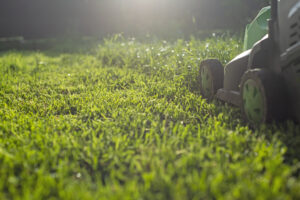If your grass is yellow, browning, or dead, it is a clear sign to water your lawn. Sometimes it’s not that obvious, though. Observing small, more subtle changes will help to know if your grass is under-watered. Here are three (3) ways to know when to water your grass:
- Color Change. It’s time to water your grass when you notice a color change — even when the change is slight. Grayish, dull-green tones typically appear first when your lawn is dehydrated.
- Curly Blades. Look at your lawn and observe the grass blades. If you notice them curled or withering, your grass is not hydrated, and it’s time to water.
- Step Test. The last method involves walking on your lawn. If the footprints you’ve left behind don’t bounce back to form, the grass blades lack the moisture they need to bounce back.
When Do I Water My Lawn?
The best time to water your lawn is first thing in the morning — before 10:00 AM. If you live in an area with more sun exposure, consider watering earlier in the morning to catch cooler, less breezy conditions. Watering in the morning allows the water to be absorbed by the grassroots before evaporation occurs. If you must water your grass in the afternoon, we recommend watering between 4:00 – 6:00 PM. Watering during peak sun hours increases evaporation which reduces growth.
If you are busy like us, you need a little help. Eden’s smart water timers are the perfect tool to water your lawn automatically. Choose what days you want to water, the time of day to water, and how long to water for a customized watering schedule.
The later in the day you water, the more likely disease will spread in among your grass. This is because many fungal and bacterial plant diseases rely on moist foliage to reproduce.
How Much Water Do I Use?
Common practice is to water established lawns until the top 1-1.5 inches of soil (where most grassroots develop) are saturated. You may reach this depth from rain or if you live in arid regions, hose-end watering tools. We recommend this amount of water for a single watering. Ensure not to overwater and that each section of your grass is hit.
What If I Am Starting from Seed?
Growing a patch of grass from seed requires a different strategy. During the germination phase, when seeds begin sprouting and developing roots, the soil must remain moist. Grass seeds need these wet environments to start the process of growth. Otherwise, grass seeds that dry out will eventually die.
Grass Seed Preparation. Water the entire area around 6-8 inches deep each day for a few days before sowing your fresh grass seed. After planting the seed, moisten the top two inches of soil for 5-10 minutes. The sown area must remain wet so that the grass seed does not dry out.
How Often Do I Water Grass Seed? Watering new grass seed is best in the mornings before 10:00 AM. If meeting this requirement is too challenging for your schedule, you may water in the evening when it’s not hot. This lessens evaporation and allows the soil to absorb more water.
Water timers may also help solve the problem. Eden’s line of Smart Watering Timers lets you schedule and adjust ahead of time, so there’s no stress over sticking to your watering routine. They are available in one, two, or four-zone units so that you can complete multiple watering tasks at once.
How Much Do I Water Grass Seed? The amount of water your new grass requires is limited by sprinkler water dispersion, soil, and the weather. Ten minutes in the morning and ten minutes in the evening should be plenty to keep the top two inches of soil moist. Water the seedlings longer and less frequently as they grow to encourage the roots to penetrate deeper into the soil.
How Long Does Grass Seed Take to Grow? The time it takes for grass seeds to germinate might range from 5 to 30 days. Because the roots will not sprout simultaneously, the soil must remain wet throughout this period until all the seeds have germinated.
Things to Avoid When Growing Grass
Evaporation. When growing new grass, especially from seed, do your best to eliminate evaporation. You can cover your new grass seed with straw or mulch.
Over-watering. Most well-prepared, new lawns are tilled to loosen the soil. Thus, this loose soil is prone to retaining lots of water. Seat soil becomes spongy and will result in compaction when walked on. In addition, higher moisture levels after seeds germinate can cause disease. Consider using Soil Moisture Sensors to stay on top of your soil’s moisture levels.
Under-watering. A lack of irrigation will cause your fresh seedlings to wither or grass blades to curl. As a result, you should create a lawn watering routine if you want the best chances of success.


